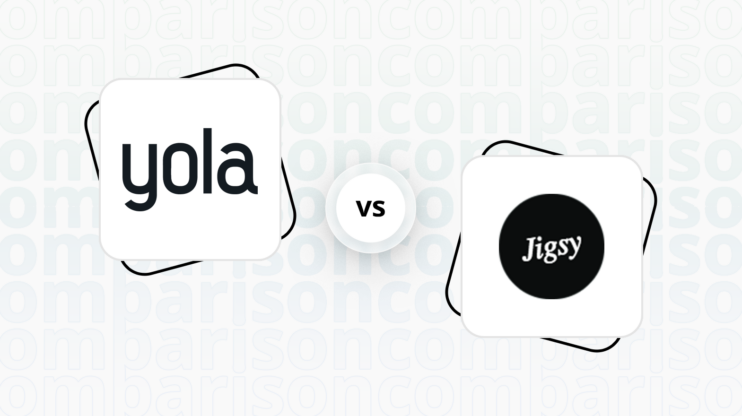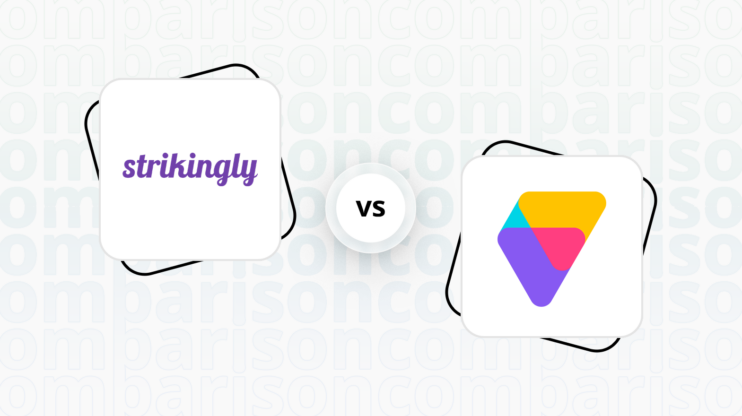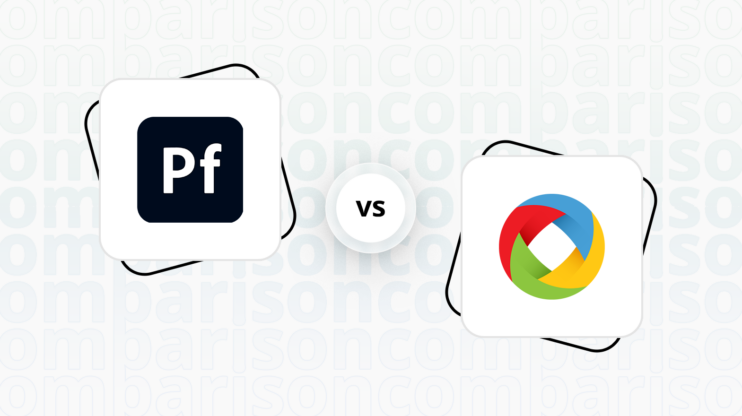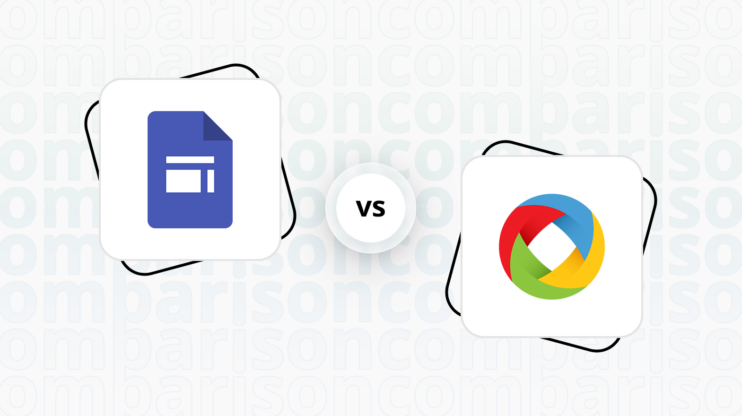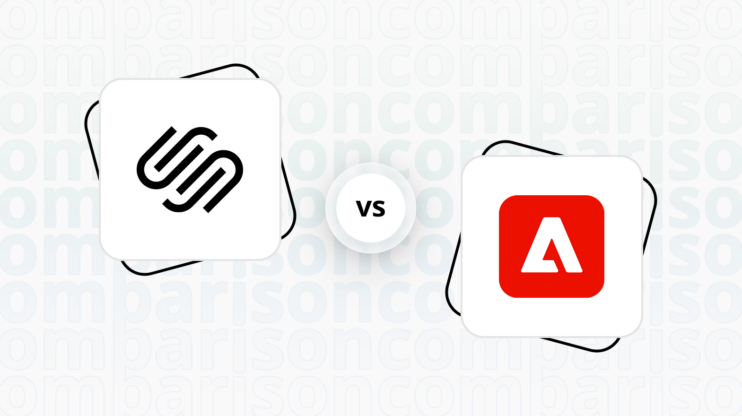Final verdict
Google Sites and Web.com offer distinct advantages for users with different needs, with Web.com slightly leading in the overall score.
-
Google Sites (Overall Grade: 5.6/10)
excels in user-friendliness and collaboration, making it an ideal choice for educational projects, team sites, and personal portfolios. Its integration with Google Workspace enhances its utility for users already embedded in the Google ecosystem. However, its limitations in design customization and lack of native ecommerce features may deter users seeking more sophisticated website functionalities. -
Web.com (Overall Grade: 5.8/10)
, on the other hand, provides a more comprehensive set of tools for building and managing websites, especially for small businesses looking to establish an online presence. With better ecommerce capabilities, a wider range of templates, and more robust marketing tools, Web.com caters to users requiring more from their website builder. Its slight edge in overall score reflects its broader feature set and flexibility, despite its learning curve and cost.

|

|
|
|---|---|---|
|
Design functionalities & templates |
4.9 |
6.4 |
|
Ease of use |
8.3 |
6.4 |
|
Ecommerce |
1.8 |
6.3 |
|
Website Editors |
7.0 |
6.6 |
|
Product testing options |
6.9 |
0.2 |
|
Price |
8.1 |
7.4 |
|
Hosting quality |
8.2 |
5.9 |
|
Website speed optimization |
3.3 |
5.8 |
|
Plugins and integrations |
6.4 |
6.7 |
|
Marketing features |
2.6 |
7.0 |
|
Customer support |
7.2 |
7.3 |
|
Security |
9.3 |
7.6 |
|
AI capabilities |
0 |
7.3 |
|
User Management |
7.8 |
5.2 |
| Overall |
5.6 |
5.8 |
Best for ecommerce
 1.8
1.8
 6.3
6.3
Verdict
: For those looking to build an ecommerce website, Web.com is the clear choice over Google Sites, offering a more robust set of features tailored for online selling.
-
Google Sites
: While Google Sites is a user-friendly platform for creating basic websites, it falls short in the ecommerce arena. It lacks built-in ecommerce capabilities, relying instead on third-party integrations for any online selling functionalities. This makes it less ideal for businesses focused on ecommerce. -
Web.com
: With a suite of ecommerce features including product listings, marketing tools, shipping options, and payment gateway integration, Web.com is well-equipped to support online stores. Its ecommerce templates and customization options make it a strong contender for businesses aiming to sell products or services online.
Best for informational & business websites
 7.2
7.2
 6.5
6.5
Verdict
: Google Sites is better suited for users prioritizing ease of use and security, while Web.com offers superior design flexibility and customer support.
-
Google Sites
: Offers a user-friendly platform with seamless integration of Google services, making it ideal for creating simple, collaborative informational sites. Its robust security features provide peace of mind for users concerned about data protection. -
Web.com
: Stands out for its design functionalities and customer support, appealing to users who need more creative control and assistance. While it may not match Google Sites in ease of use and security, it compensates with superior design options and support.
Detailed comparison
Design functionalities & templates
Design FunctionalitiesRepresents how well each platform allows for creative design and customization of websites.Score Components:
- Template Variety (30%): Range and quality of design templates.
- Customization (30%): Flexibility and options for design alterations.
- User Interface (20%): Ease and intuitiveness of the design process.
- Responsiveness (10%): Adaptability to different devices and screen sizes.
- Innovation (10%): Unique design features and tools.
 4.9
4.9
 6.4
6.4
🏆
Winner: Web.com.
If you’re looking for a platform that offers more creative control and a wide array of design features, Web.com is the preferred choice.
Google Sites offers a limited number of templates suitable for various purposes, from personal blogs to business websites, with both free and premium options available. These templates are designed for user engagement, simplicity, and functionality, allowing for customization to meet specific needs. However, compared to other website builders like 10Web or Squarespace, Google Sites might offer less variety in templates and design customization options.
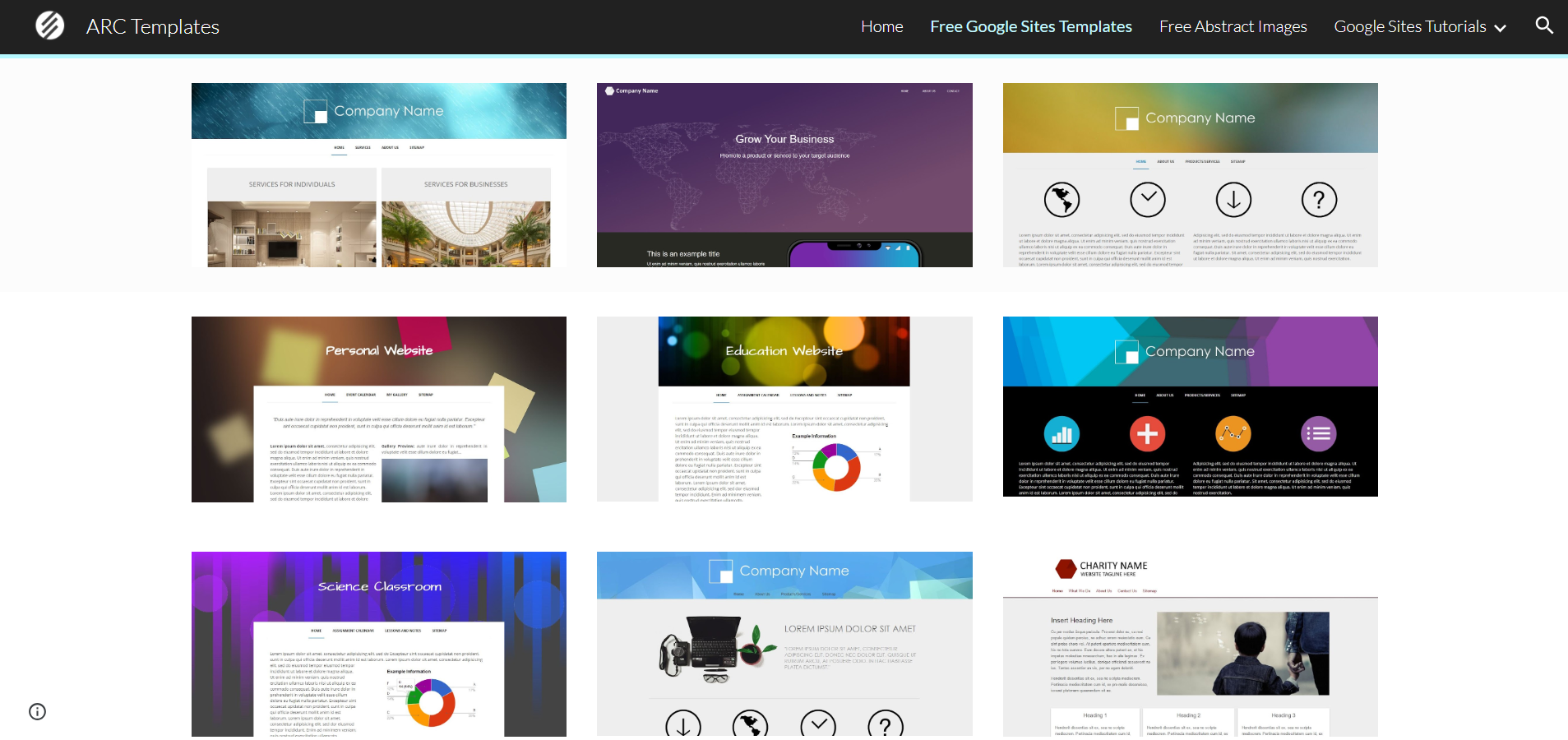

Compared to Google Sites, Web.com offers over 100 website templates designed to cater to a broad spectrum of industries and personalization needs. These templates are structured to be straightforward in customization, allowing users to easily adapt their chosen designs to suit their unique brand identity through the platform’s editor.
Get a head start on website creation with AI
Create a custom website tailored to your business needs 10X faster with 10Web AI Website Builder!
Ease of use
Ease of useReflects the platform’s overall user-friendliness.Score
Components:
- Learning curve (40%): Quickness and ease of getting started.
- Interface design (30%): Simplicity and intuitiveness of layout.
- User guidance (20%): Quality of tutorials and support.
- Flexibility (10%): Adaptability to various user skills.
 8.3
8.3
 6.4
6.4
🏆 Winner: Google Sites
. Scoring 8.3, Google Sites offers a user-friendly interface that allows individuals with no coding experience to create and publish websites easily. The drag-and-drop functionality simplifies the design process, making it accessible for users to add content, images, and customize layouts without technical difficulties. The platform integrates seamlessly with other Google services, enhancing its utility and ease of use for those already familiar with the Google ecosystem. On the other hand, Web.com, with a score of 6.4, offers a robust platform but might not be the best fit for those seeking quick, simple website setup or advanced professional design tools.
Learning Resources
🏆 Winner: Google Sites
. Google Sites offers a wide array of learning resources, spanning from practical guides for educators to create student portfolios and classroom websites to comprehensive digital skill development programs for the wider public. On the other hand, Web.com offers a range of AI-powered tools and a comprehensive knowledge base to assist users in building and managing their websites.
For ecommerce
EcommerceMeasures the platform’s effectiveness in supporting online business activities.Score Components:
- Ecommerce themes and templates (20%): Variety and design of templates.
- Product management (25%): Ease of managing and organizing products.
- Payment options (25%): Variety and convenience of payment methods.
- Ecommerce features (20%): Features for managing an ecommerce store.
- Integration (10%): Compatibility with external e-commerce tools and services.
 1.8
1.8
 6.3
6.3
When it comes to ecommerce, Web.com clearly outperforms Google Sites. Google Sites does not have built-in ecommerce features, but it allows for the integration of third-party tools or widgets for ecommerce functionalities. On the other hand, Web.com offers a suite of ecommerce features, including product listing, marketing features, shipping options, and payment gateways integration.

|

|
|
|---|---|---|
|
Ecommerce themes and templates |
0.0 |
5.5 |
|
Product page customization |
0.0 |
6.0 |
|
Payment processing and commissions |
1.0 |
6.5 |
|
POS capabilities |
0.0 |
4.0 |
|
Payment gateways |
2.0 |
7.0 |
|
Product numbers |
0.0 |
5.0 |
|
Additional ecommerce features |
0.5 |
6.0 |
Google Sites ecommerce features:
Google Sites itself does not have built-in eCommerce features.
Web.com ecommerce features:
- Product listing
- Marketing Features
- Shipping options
- Payment Gateways integration
Ecommerce themes & templates
Google Sites does not offer ecommerce templates. On the other hand, Web.com provides around 15 ecommerce templates designed to help businesses quickly launch and customize their online stores. These templates are compatible with Web.com’s website builder, facilitating straightforward customization and integration for digital storefronts.
Product page customization
Google Sites lacks any product page customization features, as the products can be listed with embedding third-party platforms, all the customization can be done within the mentioned platforms. In contrast, Web.com’s website builder offers a suite of tools for e-commerce stores, including product category management for organizing inventory and improving navigation, and product listing features for adding detailed product information and images.
Payment processing
You can integrate payment gateways into Google Sites using external tools or links, not through native features. This can be done by embedding HTML code for payment buttons from services like PayPal, Square, or Stripe, or by linking to an external checkout page. On the other hand, Web.com supports popular payment gateways like PayPal, Stripe, and all major debit and credit cards, ensuring a wide array of payment options for customers.
Website Editors
Website EditorsEvaluates the platforms’ website building and editing capabilities.Score Components:
- Customization tools (40%): Range and power of editing features.
- Editor usability (30%): User experience within the editor.
- Design flexibility (20%): Freedom in layout and design changes.
- Update and maintenance ease (10%): Simplicity of updating and maintaining the site.
 7.0
7.0
 6.6
6.6
🏆
Winner: Google Sites
. Google Sites, with a score of 7.0, offers a user-friendly website builder editor that allows users to create and design websites without needing coding knowledge. With its drag-and-drop interface, users can easily add, customize, and arrange elements such as text, images, and videos on their web pages. It also provides a variety of templates and design options to help users get started quickly and ensure their site looks professional. Additionally, Google Sites integrates seamlessly with other Google services, enabling the incorporation of Google Docs, Sheets, Slides, and Maps directly into the website.
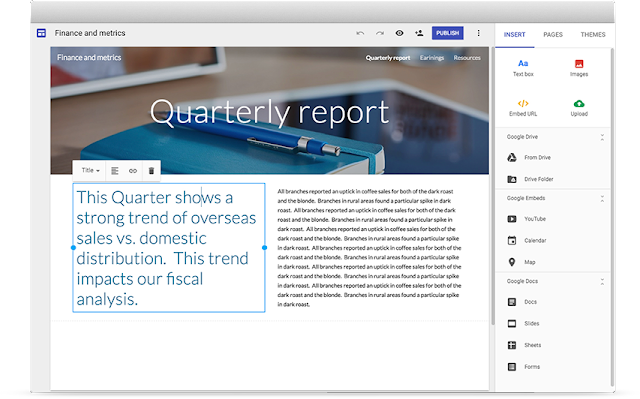
Web.com’s website builder, scoring 6.6, offers a user-friendly platform with a variety of templates and a drag-and-drop interface for easy customization, albeit with some creative limitations due to its row-based layout. It supports basic e-commerce capabilities suitable for small businesses, alongside features like analytics, social media integration, and email services. However, for more advanced functionalities like promotional pop-ups, calendars, or comprehensive blogging tools, the platform may fall short unless users are willing to add custom code.
Mobile editor/app
 0
0
 0
0
🏆
Winner: None
. Unfortunately, neither Google Sites nor Web.com offer a mobile editor or app for editing websites. This means that users will need to use a desktop or laptop computer to make changes to their websites. This could be a significant drawback for users who prefer to work on their websites on-the-go or do not have regular access to a desktop or laptop computer. Therefore, if mobile editing is a crucial feature for you, you may want to consider other website builders that offer this capability.
Product testing options
Product Testing OptionsAssesses the options for trying out platform features before commitment.Score Components:
- Trial quality (40%): Extent and usefulness of the trial or free version.
- Feature accessibility (30%): How many features are available to test.
- Trial duration (20%): Length of the trial period.
- Ease of transition (10%): Smoothness of moving from trial to paid plans.
 6.9
6.9
 0.2
0.2
Overall Result
:
Google Sites wins
. Google Sites scores 6.9, offering a free version and a 14-day trial period where some premium features can be tested. Web.com, scoring only 0.2, does not offer a free or trial version, and it’s not possible to test any features before purchasing. However, it does offer a 3-day money-back guarantee.

|

|
|
|---|---|---|
|
Free Plan |
Yes |
No |
|
Trial Duration |
14 days |
No |
|
Testing Premium Features |
Some features during free trial |
Not possible |
|
Money Back Guarantee |
No |
3 days |
Price
PriceLooks at the cost-effectiveness and value for money of each platform.Score Components:
- Plan value (40%): What each pricing tier offers.
- Transparency and clarity (30%): Clearness of pricing structures.
- Flexibility of plans (20%): Range of options to suit different budgets.
- Hidden costs (10%): Additional expenses not included in the plan.
 8.1
8.1
 7.4
7.4
Google Sites offers a range of plans suitable for different business sizes, while Web.com offers more straightforward pricing with three plans.

|

|
|
|---|---|---|
|
$0-$10 |
Business Starter ($7.20/month): This plan includes basic features suitable for individuals or small businesses, offering professional email through Gmail, 30GB of storage per user, and video meetings for up to 100 participants. It allows to manage 1 website and there is no limitation on number of pages. Value for price: 6.0 |
No offering at this amount. |
|
$10-$15 |
Business Standard ($14.40/month): Suitable for growing businesses, this plan provides 2 TB of storage per user, video meeting capacity for up to 150 participants with recording features, and access to smart booking pages and shared drives. It allows to manage 1 website and there is no limitation on number of pages. Value for price: 7.5 |
No offering at this amount. |
|
$15-$23 |
Business Plus ($21.60/month): Designed for larger businesses needing more robust capabilities, offering 5 TB of storage per user, advanced security options, and video meetings for up to 500 participants. It allows to manage 1 website and there is no limitation on number of pages. Value for price: 8.5 |
Website ($19.99/month): AI-powered Website Builder. Free domain & domain privacy for 1 year. Professional email for 3 months. SSL Certificate for 1 month. 1 hour expert design support. Social & email marketing tools. Value for price: 6.5 |
|
$23-$30 |
No offering at this amount. |
Website + Marketing ($24.99/month): All features in the Website plan. Enhanced marketing tools. Appointment scheduling. Value for price: 7.0 |
|
$30+ |
No offering at this amount. |
eCommerce ($34.99/month): All features in the Website + Marketing plan. Online store with secure checkout. Sell on multiple marketplaces like Facebook, Instagram, Amazon, eBay, etc. Value for Price: 8.5 |
location. As a result in rare cases the prices displayed here can differ from the ones you see on their
websites.
Hosting quality
Hosting
qualityExamines the reliability and performance of the hosting solutions.Score Components:
- Uptime (40%): Consistency and reliability of website availability.
- Speed (30%): Loading times and performance.
- Bandwidth and storage (20%): Sufficiency of resources provided.
- Data centers (10%): Quality and distribution of hosting infrastructure.
 8.2
8.2
 5.9
5.9
🏆
Winner: Google Sites
Google Sites offers cloud-based managed hosting with a 99.9% uptime guarantee and a network of 21 global data centers. It provides basic storage with the option to upgrade for more space. Web.com, on the other hand, offers shared hosting with unlimited storage and daily backups, but does not provide uptime statistics or guarantees, and does not disclose the locations of its data centers. This lack of transparency and guarantee gives Google Sites the edge in this category.

|

|
|
|---|---|---|
|
Do they offer hosting? |
Yes, basic storage with 100MB free per site, upgradeable |
Yes, with unlimited storage and daily backups |
|
Data Centers: |
Google operates a total of 21 data centers across the globe: 2 in Asia, 5 in Europe, 13 in US and 1 in South America |
Web.com does not disclose the locations of its data centers |
|
Type of hosting: |
Cloud based managed hosting |
Shared hosting |
|
Uptime: |
99.9% |
Web.com does not provide uptime statistics or guarantees |
|
Uptime Guarantee: |
Yes, 99.9% |
No |
Website Speed Optimization
Website Speed OptimizationEvaluates optimization of website loading timesScore Components:
- PageSpeed Score (30%): Google’s score indicating performance optimization.
- Loading Time (30%): The average time until a website is fully interactive.
- Mobile Optimization (15%): Optimization effectiveness for mobile devices.
- Resource Optimization (15%): Optimizing images, scripts, and other heavy resources.
- CDN Usage (10%): Use of CDN to enhance speed across geolocations.
 3.3
3.3
 5.8
5.8
🏆 Winner: Web.com
Both Google Sites and Web.com have strategies in place for website speed optimization, but Web.com has a higher website speed optimization score.

|

|
|
|---|---|---|
|
Focus |
Automated Optimization, CDN, Mobile Optimization, Browser Caching, Code Minification, Use of AMP |
Mobile Optimized design, Code Minification, Caching, Image Optimization |
|
Performance Tools |
Google Lighthouse, PageSpeed Insights |
Google PageSpeed Insights Integration |
|
Key Strategies |
Automated Optimization, CDN, Mobile Optimization, Browser Caching, Code Minification, Use of AMP |
Mobile Optimized design, Code Minification, Caching, Image Optimization |
|
Load Times |
Google does not disclose statistics about website Page Speed scores, or load times |
Load times and PageSpeed scores vary depending on optimization and website complexity |
|
Page Speed Scores Range |
Google does not disclose statistics about website Page Speed scores, or load times |
Load times and PageSpeed scores vary depending on optimization and website complexity |
|
Core Web Vitals Improvement |
Emphasis on LCP, FID, CLS improvements |
Web.com does not provide any information on their Core Web Vitals improvements |
Google Sites uses automated optimization, CDN, mobile optimization, browser caching, code minification, and AMP to optimize website speed. However, Google does not disclose statistics about website Page Speed scores or load times. They do place an emphasis on LCP, FID, and CLS improvements for Core Web Vitals.
Web.com, on the other hand, uses mobile optimized design, code minification, caching, and image optimization for website speed optimization. They do not provide specific information on load times, PageSpeed scores, or Core Web Vitals improvements. However, they have a higher website speed optimization score than Google Sites, making them the winner in this category.
Get a head start on website creation with AI
Create a custom website tailored to your business needs 10X faster with 10Web AI Website Builder!
Plugins and integrations
Plugins and integrationsMeasures the range and effectiveness of additional plugins and integrations.Score Components:
- Variety of options (40%): Range of available add-ons.
- Integration smoothness (30%): Ease of integrating plugins into the site.
- Quality of plugins (20%): Functionality and reliability of the options.
- Custom integration capabilities (10%): Support for custom or third-party integrations.
 6.4
6.4
 6.7
6.7
🏆 Winner: Web.com.
With a score of 6.7, Web.com slightly edges out Google Sites (6.4) in terms of plugins and integrations. Web.com offers a suite of plugins and integrations for websites built on its platform, including features for email marketing, social media engagement, analytics, and eCommerce capabilities. Google Sites, on the other hand, offers a wide array of plugins and extensions to enhance website functionality, catering to various needs such as social media integration, e-commerce, chats, forms, video, audio, and more. However, Web.com’s emphasis on facilitating robust eCommerce capabilities and SEO and marketing tools gives it a slight advantage.

Marketing Features
Design FunctionalitiesRepresents how well each platform allows for creative design and customization of websites.Score Components:
- Template Variety (30%): Range and quality of design templates.
- Customization (30%): Flexibility and options for design alterations.
- User Interface (20%): Ease and intuitiveness of the design process.
- Responsiveness (10%): Adaptability to different devices and screen sizes.
- Innovation (10%): Unique design features and tools.
 2.6
2.6
 7.0
7.0
🏆
Overall Winner: Web.com
. Web.com offers a more comprehensive set of marketing tools, including email marketing, blogging, and ads and promotions. Google Sites, while offering basic SEO and analytics features, lacks in areas like email marketing and blogging.

|

|
|
|---|---|---|
|
SEO Tools |
Basic SEO settings |
Comprehensive SEO tools |
|
Email Marketing |
No |
Yes |
|
Blogging |
No |
Yes |
|
Social Media Integration |
Basic integration with social media links and widgets |
Advanced integration with various platforms |
|
Analytics and Reporting |
Google Analytics integration |
Basic website analytics and Google Analytics setup |
|
Ads and Promotions |
No |
Yes |
Customer Support
Customer supportEvaluates the quality and availability of support options.Score Components:
- Response time (40%): Speed of support responses.
- Support quality (30%): Effectiveness and helpfulness of the support.
- Availability (20%): Range of support channels (phone, chat, email).
- Resource richness (10%): Quality of self-help and educational materials.
 7.2
7.2
 7.3
7.3
🏆 Winner: Web.com
. Although both Google Sites and Web.com offer a variety of customer support options, Web.com edges out Google Sites with its 24/7 phone, email, and live chat support. This ensures that users can get immediate help whenever they need it, regardless of the time of day.
Google Sites, on the other hand, provides customer support primarily through self-service resources like a Help Center and community forums. Direct support, including phone, email, and live chat, is available to Google Workspace customers, with the level of support varying by subscription tier. While this is a comprehensive support system, it may not be as immediate or accessible as Web.com’s 24/7 support.
When it comes to enterprise support, Google Sites offers 24/7 customer support through phone and email for its Enterprise plan users. However, Web.com does not provide any specific support for enterprises.
Security
SecurityLooks at the platforms’ security measures and data protection.Score Components:
- Data protection (40%): Safeguards for user and customer data.
- SSL and encryption (30%): Implementation of secure connections.
- Compliance (20%): Adherence to industry security standards.
- Regular updates (10%): Frequency of security updates and patches.
 9.3
9.3
 7.6
7.6
🏆
Winner: Google Sites
. Google Sites, with a security score of 9.3, offers robust security measures including SSL encryption, two-factor authentication, and automatic malware scanning. It also benefits from Google’s regular security updates and compliance with international data protection standards. Google Workspace ensures private data storage and protection through data encryption, strict access controls, and adherence to regulations like GDPR.
Web.com, scoring 7.6 in security, also provides a range of security services, including website staging environments and email solutions. It offers website security measures through its partnership with SiteLock Security, which provides cloud-based security services that scan websites for malware and vulnerabilities. However, it falls short compared to Google Sites in terms of overall security measures and score.
AI Capabilities
AI capabilitiesMeasures the effectiveness of AI-driven features and tools.Score Components:
- Automation efficiency (40%): Impact of AI on streamlining processes.
- Personalization (30%): AI-driven customization for users or customers.
- AI-Assisted design (20%): Role of AI in website design and functionality.
- Data analysis (10%): Use of AI in interpreting user data and analytics.
 0
0
 7.3
7.3

|

|
|
|---|---|---|
|
AI Website Builder |
|
Web.com offers an AI website builder for easy website creation |
|
AI Ecommerce Features |
|
AI-driven ecommerce features for enhanced online shopping |
|
AI Content Generation |
|
AI Writer for versatile content creation |
|
Additional AI Features |
|
AI Domain Generator and AI Logo Builder for branding |
🏆 Winner: Web.com
. With a score of 7.3, Web.com offers a range of AI capabilities designed to simplify the website creation process and enhance the user experience. These include an AI website builder, AI ecommerce features, AI content generation, and additional AI features such as an AI Domain Generator and an AI Logo Builder.
On the other hand, Google Sites, with a score of 0, does not have any AI capabilities. This means that while Google Sites may offer a straightforward website building experience, it lacks the advanced AI features that can streamline the process and enhance the final product.
User Management
User ManagementAssesses the platforms’ capabilities in managing user roles, permissions, and accessibility.Score Components:
- Role Customization (40%): Flexibility in creating and defining user roles and
permissions. - Ease of Management (30%): User interface and tools for managing users.
- Access Control (20%): Effectiveness of access control measures for different user
levels. - Scalability (10%): Ability to manage a growing number of users efficiently.
 7.8
7.8
 5.2
5.2
🏆 Winner: Google Sites
. Google Sites and Web.com both allow multiple users to collaborate on a website, but they offer different levels of control and access.
- Google Sites allows multiple users to collaborate with different roles, including Owners, who have full control, and Editors, who can modify content but not site settings. There’s no strict limit on the number of users who can edit a site, allowing flexibility in management and development. Viewers can only see the site, with no editing permissions. This structure supports collaborative website building with varied levels of access and control for different users.
- Web.com allows multiple user accounts, however the platform does not specify how many accounts are supported.
Web.com User Roles and Access Levels:
| Role | Description | Access Highlights |
|---|---|---|
| Primary | The main account holder or primary user. | Edit primary user info Purchase products Manage and renew products and services |
| Admin | Users with administrative privileges besides the primary. | Edit payment information Add/Edit/Delete user roles Manage and renew products and services Edit WHOIS Admin and Tech user info |
| Tech | Users with technical responsibilities. | Manage and renew products and services Edit WHOIS Admin and Tech user info |
Additional Features

|

|
|
|---|---|---|
|
SSL Certificate |
|
|
|
Custom Domain |
|
|
|
Free Custom Domain Included |
|
|
|
International Domains |
|
|
|
Mobile Responsive |
|
|
|
Page Speed |
|
|
|
Website Builder Mobile App |
|
|
|
Convert a Website To An App |
|
|
|
Website Analytics |
|
|
|
Multilingual Sites |
|
|
|
Multiple Users |
|
|
User Feedback
Users consistently praise Google Workspace, particularly Google Sites, for its seamless integration, ease of use, and collaborative features, making it a go-to solution for various professional and educational needs. The platform’s simplicity and user-friendly interface are lauded, enabling effortless website creation and sharing of information within organizations. While some users desire more customization options and additional features, overall, Google Workspace remains highly valued for its versatility and streamlined workflow facilitation.
Unfortunately, there is no user feedback summary available for Web.com. This could be due to the fact that Web.com is not available on the G2 platform, which is a popular platform for user reviews and feedback. Therefore, it’s difficult to provide a comprehensive comparison of user feedback between Google Sites and Web.com.
The making of this blog
We followed a clear, step-by-step process to write and research this article.
FAQ
Which platform is better for ecommerce, Google Sites or Web.com?
Can I use Google Sites and Web.com for creating informational business websites?
How do Google Sites and Web.com compare in terms of design functionalities and templates?
Which platform is easier to use for beginners?
How do the website editors of Google Sites and Web.com compare?
Which platform offers better customer support?
Are there any differences in security between Google Sites and Web.com?
Which platform has better AI capabilities?










